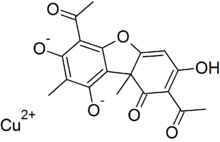
Sulfuric acid or sulphuric acid, known in antiquity as oil of vitriol, is a mineral acid composed of the elements sulfur, oxygen and hydrogen, with the molecular formula H2SO4. It is a colorless, odorless and viscous liquid that is miscible with water.

Etching is traditionally the process of using strong acid or mordant to cut into the unprotected parts of a metal surface to create a design in intaglio (incised) in the metal. In modern manufacturing, other chemicals may be used on other types of material. As a method of printmaking, it is, along with engraving, the most important technique for old master prints, and remains in wide use today. In a number of modern variants such as microfabrication etching and photochemical milling it is a crucial technique in much modern technology, including circuit boards.

Lichenology is the branch of mycology that studies the lichens, symbiotic organisms made up of an intimate symbiotic association of a microscopic alga with a filamentous fungus.

Kombucha is a fermented, lightly effervescent, sweetened black tea drink commonly consumed for its purported health benefits. Sometimes the beverage is called kombucha tea to distinguish it from the culture of bacteria and yeast. Juice, spices, fruit or other flavorings are often added.

Malachite is a copper carbonate hydroxide mineral, with the formula Cu2CO3(OH)2. This opaque, green-banded mineral crystallizes in the monoclinic crystal system, and most often forms botryoidal, fibrous, or stalagmitic masses, in fractures and deep, underground spaces, where the water table and hydrothermal fluids provide the means for chemical precipitation. Individual crystals are rare, but occur as slender to acicular prisms. Pseudomorphs after more tabular or blocky azurite crystals also occur.

Cladonia rangiferina, also known as reindeer cup lichen, reindeer lichen or grey reindeer lichen, is a light-colored fruticose, cup lichen species in the family Cladoniaceae. It grows in both hot and cold climates in well-drained, open environments. Found primarily in areas of alpine tundra, it is extremely cold-hardy.

Copper(II) oxide or cupric oxide is an inorganic compound with the formula CuO. A black solid, it is one of the two stable oxides of copper, the other being Cu2O or copper(I) oxide (cuprous oxide). As a mineral, it is known as tenorite. It is a product of copper mining and the precursor to many other copper-containing products and chemical compounds.

Ethnolichenology is the study of the relationship between lichens and people. Lichens have and are being used for many different purposes by human cultures across the world. The most common human use of lichens is for dye, but they have also been used for medicine, food and other purposes.

Usnic acid is a naturally occurring dibenzofuran derivative found in several lichen species with the formula C18H16O7. It was first isolated by German scientist W. Knop in 1844 and first synthesized between 1933-1937 by Curd and Robertson. Usnic acid was identified in many genera of lichens including Usnea, Cladonia, Hypotrachyna, Lecanora, Ramalina, Evernia, Parmelia and Alectoria. Although it is generally believed that usnic acid is exclusively restricted to lichens, in a few unconfirmed isolated cases the compound was found in kombucha tea and non-lichenized ascomycetes.

Flavoparmelia baltimorensis, the rock greenshield lichen, is a medium to large foliose lichen with a yellow green upper thallus surface when dry; its lobes are rounded without pseudocyphellae; and the upper surface is covered with globose, pustule-like growths resembling isidia. The lower surface is black with a narrow brown zone at the margins.
In enzymology, a (S)-usnate reductase (EC 1.1.1.199) is an enzyme that catalyzes the chemical reaction
An antitrichomonal agent is an antiprotozoal agent that acts on trichomonas parasites.

Vulpicida is a genus of lichenized fungi in the family Parmeliaceae. Circumscribed in 1993 to contain species formerly placed in Cetraria, the genus is widespread in Arctic to northern temperate regions, and contains six species. The genus is characterized by the presence of the secondary metabolites pulvinic acid and vulpinic acid, compounds that when combined with usnic acid, give the species their characteristic yellow and green colors.

Cladonia stellaris or the star-tipped cup lichen is an ecologically important species of cup lichen that forms continuous mats over large areas of the ground in boreal and arctic regions around the circumpolar north. The species is a preferred food source of reindeer and caribou during the winter months, and it has an important role in regulating nutrient cycling and soil microbiological communities. Like many other lichens, Cladonia stellaris is used by humans directly for its chemical properties, as many of the secondary metabolites are antimicrobial, but it also has the unique distinction of being harvested and sold as 'fake trees' for model train displays. It is also used as a sound absorber in interior design. The fungal portion of Cladonia stellaris, known as a mycobiont, protects the lichen from lichenivores, superfluous solar radiation, and other kinds of stressors in their ecosystem.
Lecanora achroa is a species of crustose lichen in the family Lecanoraceae. It was originally described in 1876 by Finnish botanist William Nylander from specimens collected in Rodrigues, Mauritius. The lichen is found in Australia, New Zealand, Papua New Guinea, and North and South America.
Pulchrocladia corallaizon is a species of lichen in the family Cladoniaceae. It was first formally described as Cladia corallaizon. The specific epithet corallaizon, modified from Greek, means "ever-living coral". In 2018, it was transferred to the newly circumscribed genus Pulchrocladia.
Xanthoparmelia lobuliferella is a species of saxicolous (rock-dwelling), foliose lichen in the family Parmeliaceae. Found in South Africa, it was formally described as a new species in 2002 by Australian lichenologist John Elix. The type specimen was collected from the Jonaskop mountain at an altitude of 1,600 m (5,200 ft); there it was found growing on south-facing rocks. It contains several lichen products: major amounts of usnic acid and stictic acid, and minor amounts of constictic acid, norstictic acid, cryptostictic acid, lobaric acid, stenosporonic acid, lichesterinic acid, and protolichesterinic acid. The species epithet refers to its resemblance to Xanthoparmelia lobulifera.
Xanthoparmelia malawiensis is a species of saxicolous (rock-dwelling), foliose lichen in the family Parmeliaceae. Found in Malawi, it was formally described as a new species in 2002 by Australian lichenologist John Elix. The type specimen was collected in Nyika National Park at an altitude of 2,300 m (7,500 ft), where it was found growing on granite rocks. It is only known from the type locality. It contains usnic acid and stictic acid as major lichen products, and minor amounts of constictic acid, norstictic acid, cryptostictic acid, and lusitanic acid.
Xanthoparmelia micromaculata is a species of saxicolous (rock-dwelling), lichen in the family Parmeliaceae. Found in South Africa, it was formally described as a new species in 2002 by Australian lichenologist John Elix. The type specimen was collected from the summit of Waboomsberg mountain at an altitude of 1,220 m (4,000 ft). It is only known from the type locality. The lichen has a pale yellow-green, somewhat crustose thallus, reaching a diameter of up to 1 cm (0.4 in) wide. It contains several lichen products: stictic acid as a major metabolite, minor amounts of usnic acid, constictic acid, and hypostictic acid, and minor or trace amounts of norstictic acid, hyposalazinic acid, and cryptostictic acid. The species epithet refers to the prominent maculae on the thallus surface.

Xanthoparmelia angustiphylla is a foliose lichen that belongs to the genus Xanthoparmelia.













